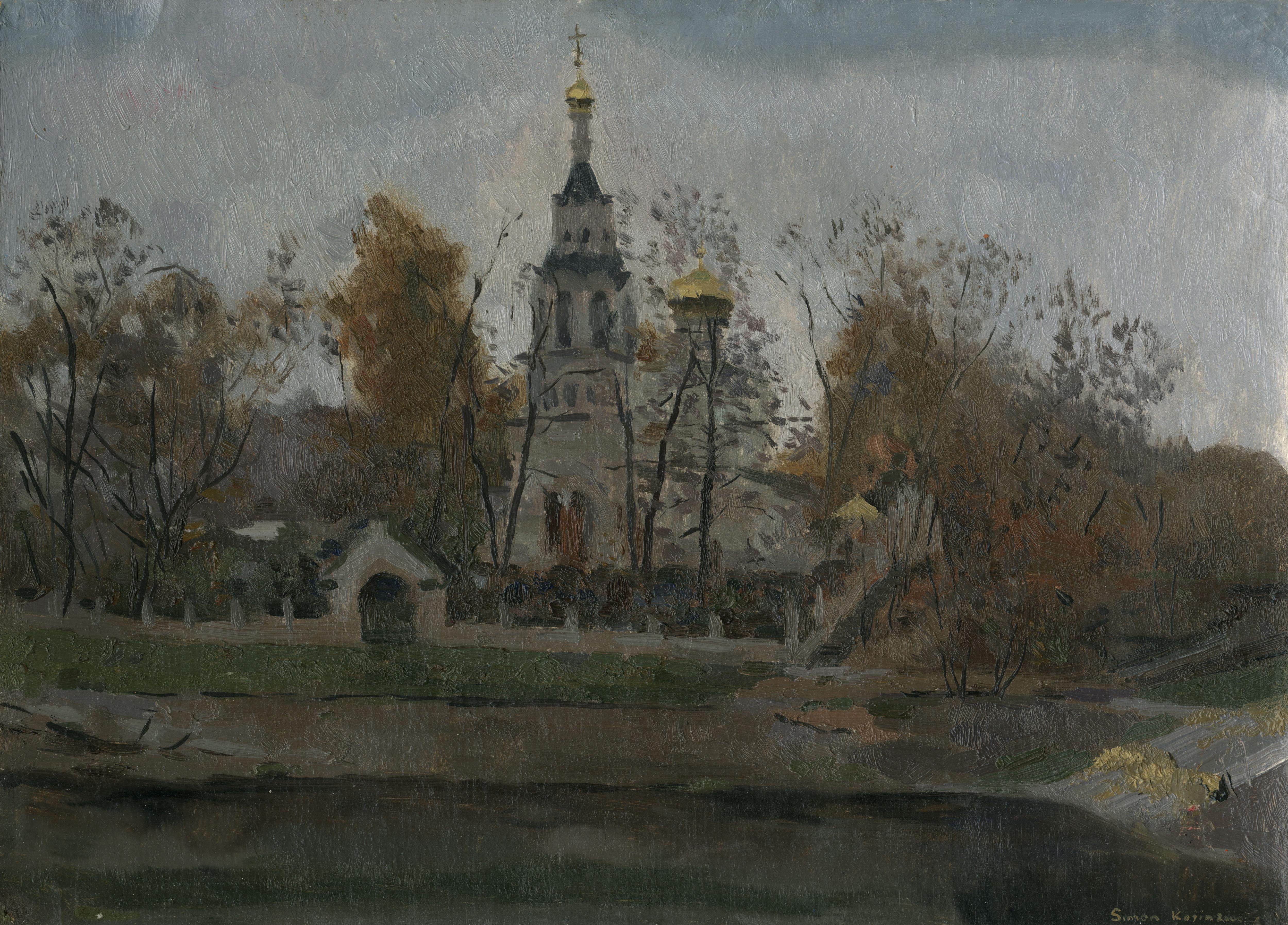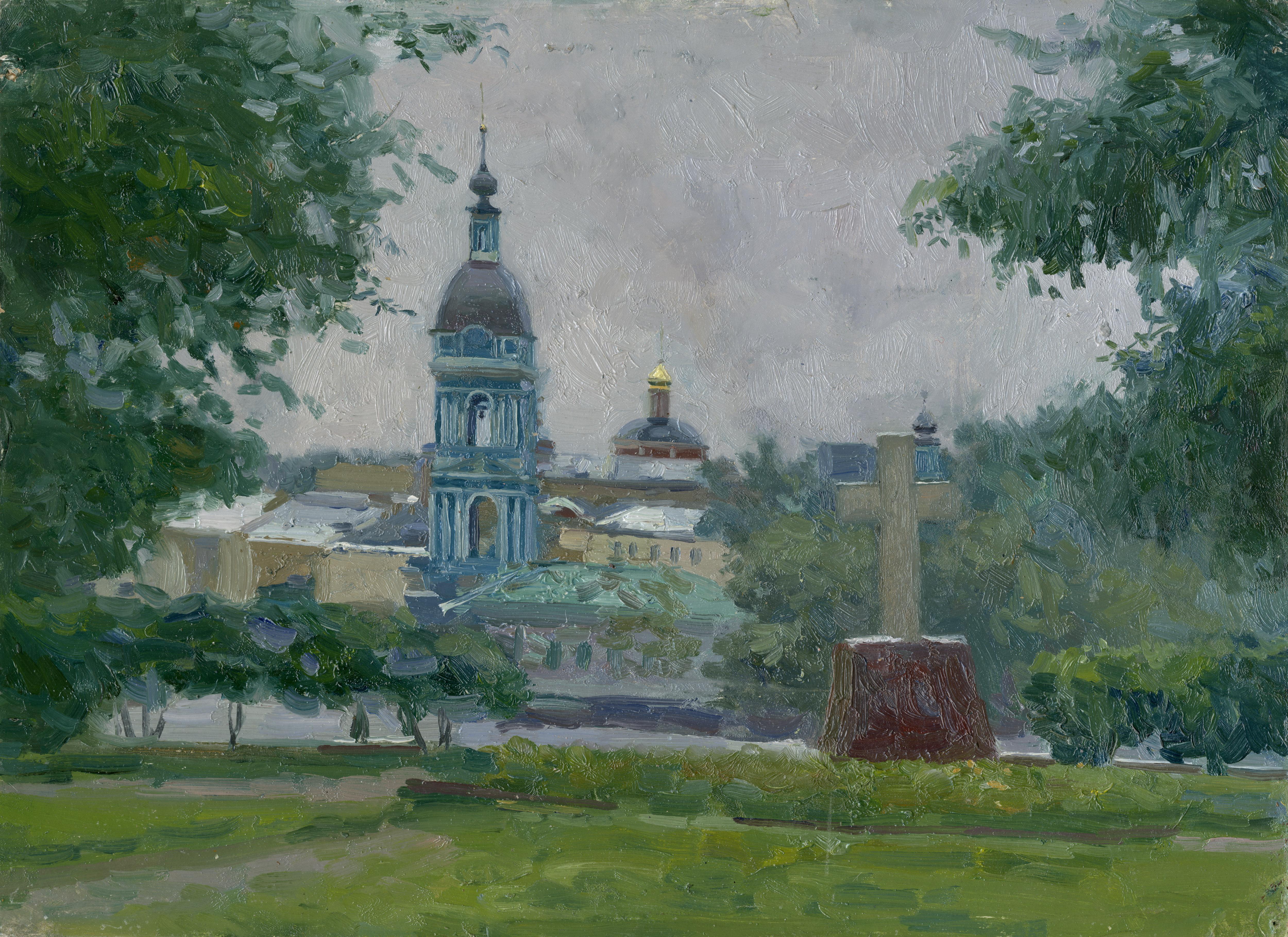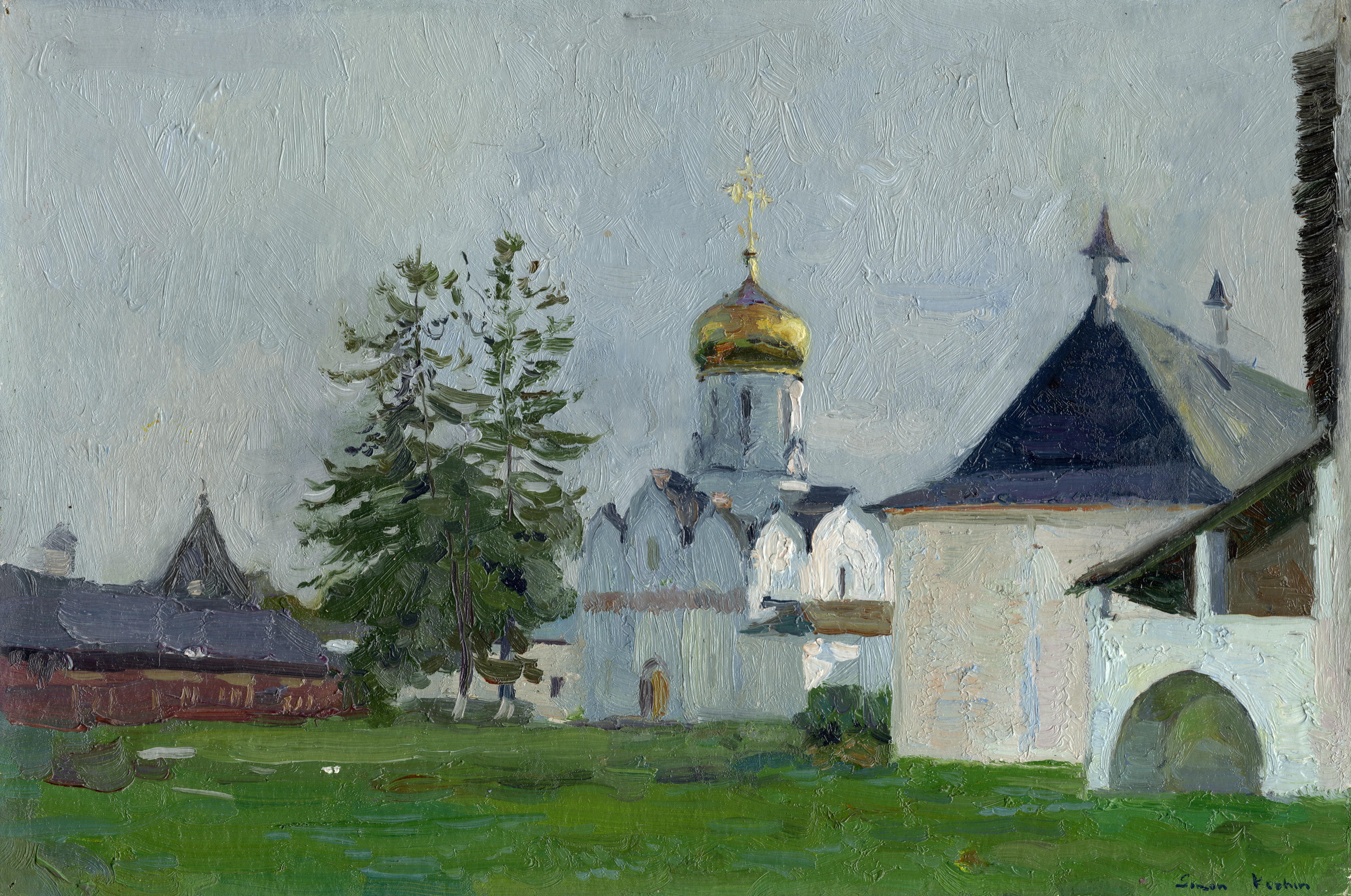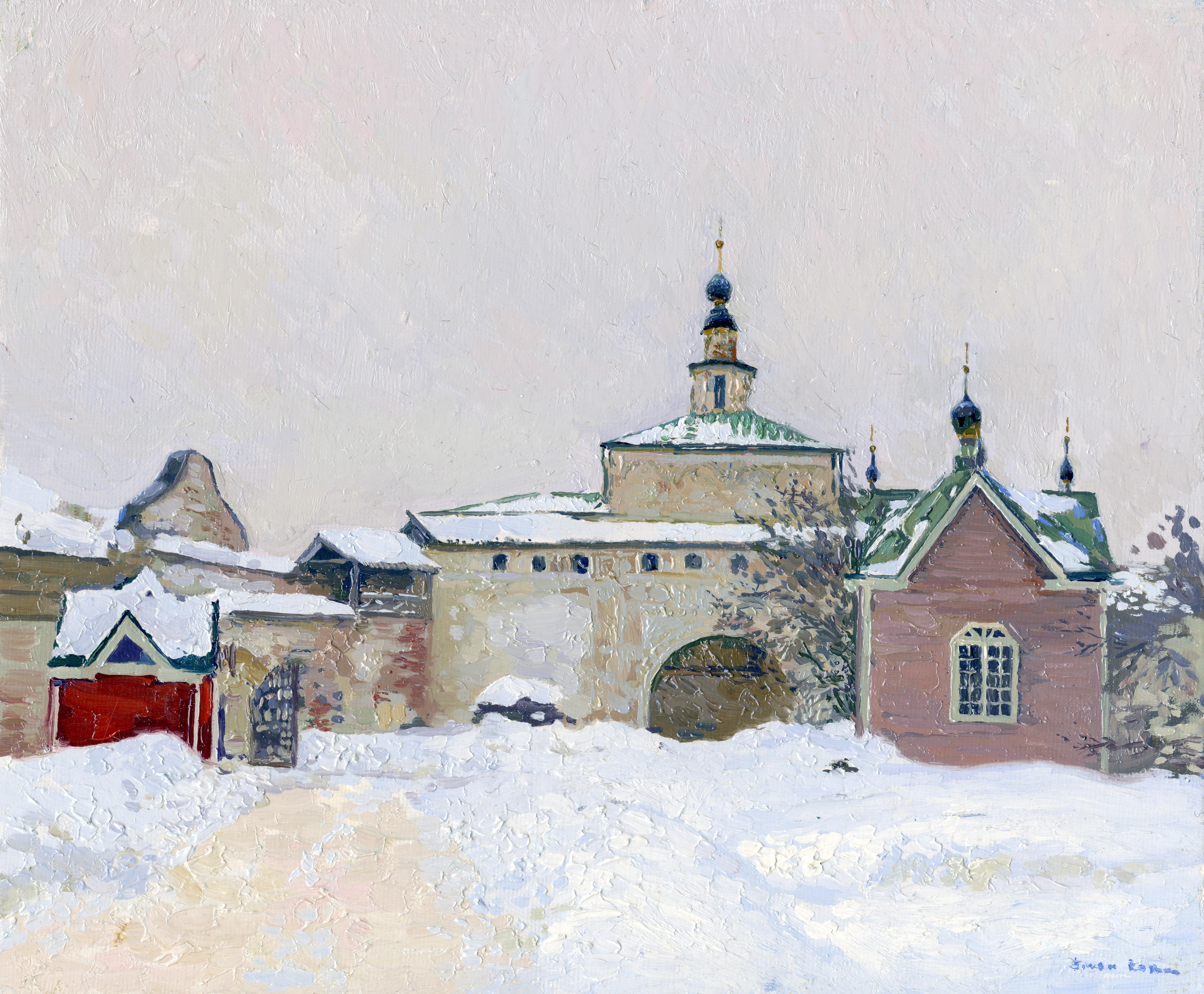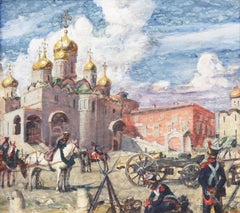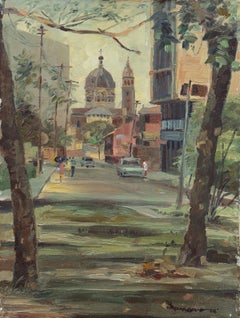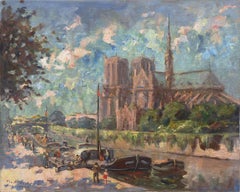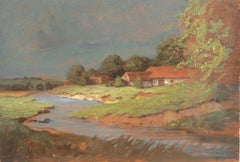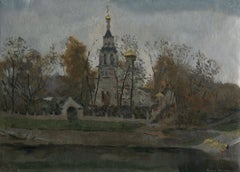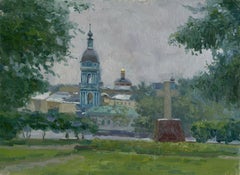Items Similar to 'Church of Elijah the Prophet, Yarolsavl City', Ilaskaya Church, Russia, Oil
Want more images or videos?
Request additional images or videos from the seller
1 of 13
Valentin Nikolaevich Leontiev'Church of Elijah the Prophet, Yarolsavl City', Ilaskaya Church, Russia, OilCirca 1965
Circa 1965
$6,500
£4,935.60
€5,644.23
CA$9,081.44
A$10,100.55
CHF 5,274.19
MX$122,912.91
NOK 67,359.47
SEK 63,171.30
DKK 42,125.06
Shipping
Retrieving quote...The 1stDibs Promise:
Authenticity Guarantee,
Money-Back Guarantee,
24-Hour Cancellation
About the Item
Signed, verso, in Cyrillic, 'Leontev V.E.' for Valentin Nikolaevich Leontiev (Russian, 1912-1984) and inscribed, 'City of Yarolsavl on the River Volga. Painter, Leontev V.E. Showing Ilaskaya Church, symbol of 17th Century architecture'. Painted circa 1965. Accompanied by old framing label bearing title, 'Church of the Prophet Elijah'.
Displayed in a burnished gilt-wood frame; framed dimensions: 21.5 H x 17.5 W x 1.5 D inches
Valentin Nikolaevich Leontiev; painter, teacher. Honored Worker of Culture of the USSR (1973).
Member of the Great Patriotic War of 1941-1945. He was awarded a commemorative medal. Medal "For Valiant Labor. In commemoration of the 100th anniversary of the birth of V.I. Lenin. Member of the Union of Artists of Russia (1947). Chairman of the Board of the Yaroslavl Union of Artists (1961-1964), member of the board until 1982.
In 1931 he graduated from the Yaroslavl Art and Pedagogical College (teacher - S.F. Shitov) and continued his studies in Leningrad (teachers - I.I. Brodsky, A.A. Osmerkin, B.V. Ioganson). He was a Stalin scholarship holder. In 1941, from the 6th graduation course of the institute at the Academy of Arts, he volunteered for the front. Participated in battles near Narva and Kingisepp (North-Western Front). When the regiment left the encirclement, he was captured, in April 1945 he was liberated by the allied forces in Germany on the river. Elbe. After his release, he fought on the 2nd Belorussian Front, participated in the battles near Königsberg.
In 1947 he graduated from the Leningrad Institute of Painting, Sculpture and Architecture. I.E. Repin of the Academy of Arts of the USSR, having defending his thesis - the monumental composition "Meeting of the Winners". After graduation, he taught at the Cheboksary (Chuvash ASSR) art school (1949-1951). In 1951 he returned to Yaroslavl and for 32 years (1951-1983) taught at an art school. There are many well-known artists among the students of Valentin Nikolaevich Leontiev.
In addition to many landscapes ( " Morning in Yaroslavl " (1967), " Industrial motive " , " The Church of Elijah the Prophet " (1956), " Hoarfrost "(1979) and others), as well as chamber works in the genre of still life, V.N. Leontiev created several significant thematic canvases, including: " Weekend Morning in Cheboksary " (1950 - Chuvash State Art Museum), " Building Communism " (1951, YAHM).
Participant of regional, interregional, zonal, regional, republican and all-Union exhibitions. Personal exhibitions in Yaroslavl: 1972, 1983 and 1997. V.N. Leontiev participated in the work of several congresses of the Union of Artists of the RSFSR and the Union of Artists of the USSR, in the formation of regional exhibitions. Works by V.N. Leontiev are kept in the museum collections of Yaroslavl, in Russian and foreign private collections.
From the introductory article to the exhibition catalog "Valentin Nikolaevich Leontiev and his students ” , 2008 Art critic Olga Shikhanova.
He was loved by both students and fellow artists. Many even now remember with a smile many funny stories associated with the name of Valentin Nikolaevich Leontiev, one of the most significant painters of Yaroslavl. Many are still grateful to him for the lessons of mastery, for patience and tolerance, for a sincere interest in their first, albeit timid, steps in art and for a personal example of passion for creativity.
A native Yaroslavl, Leontiev was born on February 5, 1912. His father was a wagon coupler on the railroad and died when his son was 7 years old. Mother Alexandra Nikolaevna worked all her life as a painter at one of the oldest paint and varnish enterprises in the country - the Victory of Workers plant.
An inquisitive and active boy at the age of ten joined the first pioneer detachment on Krasny Perekop and from that time became addicted to drawing. Valentin received his initial art diploma in the then popular working studios of fine arts, and in the Yaroslavl Art School, where he entered in 1928, his teachers were wonderful teachers Sergei Fedorovich Shitov and Pyotr Nikolaevich Shadrikov, who stood at the origins of the Yaroslavl art school.
In 1931, after defending his diploma, Leontiev received a referral to the Victory of Workers factory, where he conscientiously performed the usual work for a factory artist: he wrote slogans, drew wall newspapers, designed stands with the results of socialist competitions. Such work could not give real creative satisfaction to a person with his pictorial possibilities. In 1933, Valentin first entered the preparatory classes of the All-Russian Academy of Arts, and in 1935 became a student.
Art and creative work carried away, and the names of the teachers I. Brodsky, A. Osmyorkin, B. Ioganson, E. Serov, R. Frentz, A. Zaitsev, who had already entered the history of Russian art, turned their heads. In 1940, for excellent progress, Vadentin was awarded the highest student award - a state scholarship. Even then, Leontiev's leadership qualities appeared, and in 1938 he was elected a member of the Student Youth Council under the Central Committee of the Komsomol.
For the diploma, he painted a large-scale painting "Children on the Volga" (headed by A.I. Savinov). These few Leningrad years were the happiest in Leontiev's life. After all, it was there, within the walls of the Academy, that he met a friend for life - Evsey Moiseenko, and there he met his only love, Tanya Edelson. The wedding was played in a student hostel in January 1941. But June 1941, like many young people of his generation, dramatically changed the life that had begun so wonderfully. The terrible word "War!"
Leontiev and Moiseenko, academic scholarship holders, on whom great hopes were placed, were completely exempted from military service, but both made the only choice possible for them at that time: instead of defending their diploma, in July 1941 they signed up as volunteers in the people's militia. On a memorable day, a large group of students gathered at the Academy - future historians, artists, musicians - all of whom the slogan "Leningrad is in danger!" also did not leave indifferent. From there, everyone went first to the militia, and then to the front. Private of the 4th Volunteer Division, Leontiev participated in the construction of defensive fortifications around Leningrad. The militias dug the ground, constructing anti-tank ditches and pillboxes. After heavy fighting near Narva and Koenigsberg, some colonel undertook to take them out of the encirclement. And so it happened that led untrained soldiers directly to the Germans. So Leontiev was captured, and soon ended up in Germany. Repeated attempts to escape each time ended in raids and brutal reprisals. Finally, he was given as free slaves to a German farm, where he stayed until the arrival of the Red Army.
It was a difficult time for Leontiev's wife, Tatyana: in November 1941, their son Vladik was born in Anapa. She survived nine months of occupation and the inability to learn anything about the fate of her husband.
Freed from captivity, Leontiev served in the 128th separate communications battalion of the 24th Army of the Belorussian Front until October 1945, and all this time he tried to contact his relatives. He was considered missing. Finally, Valentin was reunited with his family, and then a wonderful portrait of his son appeared, which the artist painted on the same day - “Vladik. Meeting with my son. Leontiev's graduation work was lost during the war years. Having written under the guidance of B.V. Ioganson and V.A. Serov's new large painting "Meeting of the Winners" (280x350), Valentin in 1947 defended his diploma. The high commission rated Leontiev's thesis work as an undoubted success. He and Yevsey Moiseenko were given a state subsidy, which makes it possible for some time to comfortably engage in free creativity.
Already the first works of Leontiev ("Son", "Neva" - 1946, "In the Harbor" - 1947) were so mature that the receipt of a diploma almost coincided with his entry into the Union of Artists (1947). Soon V.N. Leontiev began teaching at the Cheboksary Art School and wrote extensively. Among his works are large canvases "Day off in Chuvashia", "Volga near Cheboksary" - 1950. In 1951 the family moved to Yaroslavl. Tatyana was engaged in scientific work, took care of replenishing the collection of the art museum. Valentin began to teach at his native school and participate in exhibitions. Suddenly, their only son, who had only recently become a student at the Pedagogical Institute, died of a serious illness. The parents were literally broken. Soon the family adopted a boy from an orphanage near Moscow. Seryozha was not very healthy, but the Leontievs did everything to put their adopted son on his feet.
A painter and a talented teacher, Valentin Nikolaevich Leontiev, during his 35 years of creative and pedagogical activity, created hundreds of canvases filled with poetry that reflected his love for his native land, brought up hundreds of students with whom he shared their successes and failures, helped to gain faith in himself and cope with all the difficulties of mastering the profession. And he himself has always been an example for them. A talented colorist, he always wrote a lot and with pleasure: in the House of Creativity, in the country or together with students at the annual summer practice. After a long period of work, these nature studies in the workshop turned into beautiful genre paintings filled with deep content (“Communism Construction Sites” - 1951, “Southern Bazaar” - 1956, “Yaroslavl” - 1959, “In Winter on the Volga” - 1963, “Mourning Day” - 1970). In them, even sometimes timed to the next party dates,
In Yaroslavl, the landscape genre has always been a priority, and gradually Leontiev began to move more and more away from large thematic canvases, but also in simple sketches, such as “The End of Summer” (1956), “Morning. Yaroslavl" (1967), "Cornflowers on the Piano" (1967), "First Greens" (1968), "Winter. Old Yaroslavl "(1976) Leontiev set himself and successfully solved complex creative tasks.
In 1973 V.N. Leontiev was awarded the Honorary title "Honored Worker of Culture of the RSFSR". For five years he headed the regional organization of the Union of Artists, participated in the congresses of the Union of Artists of Russia and the Union of Artists of the USSR, was a member of the regional and zonal exhibition committees. Despite his softness and tact, in matters of principle, Valentin Nikolayevich could show firmness and exactingness, which is why his opinion was so authoritative for his colleagues in art.
Colleagues remember Valentin Nikolaevich as an unsurpassed master of the beginning of the picture. First, he filled the canvas with a local delicate color, grasping the almost elusive mood of nature, and only then proceeded to drawing the details. As a result, realistic in form and content, reverently romantic in spirit canvases were born.
V.N. died. Leontiev on January 7, 1984, shortly after his second major solo exhibition, which was successfully held in the exhibition halls of the Union of Artists, reflecting the creative growth and breadth of interests of this remarkable painter. The exhibition, organized in honor of his 70th birthday, then gathered a lot of admirers of his talent.
A deeply intelligent, quiet, thoughtful and conflict-free person of extraordinary talent, an artist “by the grace of God,” literally all his friends say about him. And when I ask one of them to tell about Valentin Nikolayevich, I see how their faces invariably warm up.
- Creator:Valentin Nikolaevich Leontiev (1912 - 1984, Russian)
- Creation Year:Circa 1965
- Dimensions:Height: 19.25 in (48.9 cm)Width: 15.25 in (38.74 cm)Depth: 0.75 in (1.91 cm)
- Medium:
- Movement & Style:
- Period:
- Condition:painting: minor restoration, minor losses, edges of canvas reinforced and re-stretched onto new maple stretcher due to woodworm in original stretcher; frame: minor marks, minor losses; shows well.
- Gallery Location:Santa Cruz, CA
- Reference Number:1stDibs: LU34411270362
About the Seller
5.0
Platinum Seller
Premium sellers with a 4.7+ rating and 24-hour response times
Established in 1982
1stDibs seller since 2013
741 sales on 1stDibs
Typical response time: 1 hour
- ShippingRetrieving quote...Shipping from: Santa Cruz, CA
- Return Policy
Authenticity Guarantee
In the unlikely event there’s an issue with an item’s authenticity, contact us within 1 year for a full refund. DetailsMoney-Back Guarantee
If your item is not as described, is damaged in transit, or does not arrive, contact us within 7 days for a full refund. Details24-Hour Cancellation
You have a 24-hour grace period in which to reconsider your purchase, with no questions asked.Vetted Professional Sellers
Our world-class sellers must adhere to strict standards for service and quality, maintaining the integrity of our listings.Price-Match Guarantee
If you find that a seller listed the same item for a lower price elsewhere, we’ll match it.Trusted Global Delivery
Our best-in-class carrier network provides specialized shipping options worldwide, including custom delivery.More From This Seller
View All'Napoleonic Guard at the Cathedral of Uspensky Sobor', Moscow, French Militaria
By Charles Hoffbauer
Located in Santa Cruz, CA
Initialed lower left, 'C.H.' for Charles Constantine Hoffbauer (French, 1875-1957) and painted circa 1900.
Accompanied by the original artist-signed mat, original backing with inscription and newspaper clipping from Los Angeles Times' review of Hoffbauer's 1949 Legion of Honor Exhibition.
Mat dimensions: 12.75 x 13.5 Inches
An exceptionally fine and detailed, cabinet-sized gouache showing members of the Napoleonic guard relaxing in the courtyard of the Cathedral of Uspensky Sobor during France's brief occupation of Moscow during the fall of 1812.
Born in Paris in 1875, Charles Hoffbauer studied at the Ecole des Beaux-Arts under Fernand Cormon and Gustave Moreau and, during his studies, became acquainted with Matisse, Rouault, and Marquet. He was the recipient of numerous prizes, medals and juried awards including an Honorable Mention in the Salon of 1896, and prizes at the Salons of 1898 and 1899. He was awarded a bronze medal at the Paris Universal Exposition of 1900 and, in the same year, a French government scholarship, the Prix National du Salon, that allowed him to travel and study in Italy, Greece and Egypt. In 1902, he won the Prix Rosa Bonheur. At the Salon of 1904, the French government purchased 'Champs de Bataille' for the Musée du Luxembourg and Hoffbauer was elected a member of the Legion of Honor.
Hoffbauer served in the French Army as an official war artist during the first world war, winning the Croix de Guerre and acting as liaison officer to the American camouflage section. On the recommendation of the mural painter, James Wall Finn, Hoffbauer received the 1935 commission to paint the murals for Battle Abbey, the Confederate memorial in Richmond, Virginia. He revisited America to accept a commission for the mural in the Missouri State Capitol, and was appointed to membership of the jury of the 1937 International Exposition. Two years later, he became an American citizen and settled in Rockport, Massachusetts. Charles Hoffbauer's work may be found in the permanent collections of numerous national museums including the Museum of Modern Art in Paris.
Reference:
Who Was Who in American Art 1564-1975: 400 Years of Artists in America, Peter Hastings Falk, Sound View Press 1999, Vol. 2, p. 1585; Thieme-Becker Allgemeines Lexikon der Bildenden Künstler von der Antike bis zu Gengenwart, Ulrich Thieme and Felix Becker, Deutscher Taschenbuch Verlag 1992, Vol. 17/18, p. 246; E. Benezit, Dictionnaire des Peintres, Sculpteurs, Dessinateurs, et Graveurs, Jacques Busse, 1999 Nouvelle Édition, Gründ 1911, Vol. 7, p. 105; Biographical Encyclopedia of American Painters, Sculptors & Engravers of the U.S.: Colonial to 2002, Bob Creps, Dealer’s Choice Books, Inc. 2002, Vol. 1, p. 643; Steen, James T. "The Story of a Painting," Carnegie Magazine 31/32 (February 1957): 57-59; Charles Hoffbauer (1875-1957). Drawings, Temperas & Oil Paintings. Exh. cat. Somerville, MA: Gropper Art Gallery, 1977; Glueck, Grace. New York: The Painted City. Salt Lake City: Peregrine Smith Books...
Category
1940s Realist Landscape Drawings and Watercolors
Materials
Paper, Gouache
'Manila, Cathedral of the Immaculate Conception', Intramuros General Luna Street
Located in Santa Cruz, CA
Signed lower right indistinctly, ( A.B. Delarova? ) and dated, '68''. Inscribed verso, 'Manila, Cathedral of the Immaculate Conception viewed from General Luna Street'.
A deftly-painted, tonalist oil painting showing of this elegant section of Manila with the silhouette of the dome of the cathedral as viewed from the far end General Luna Street. This minor basilica (Catedral Metropolitana de la Inmaculada Concepción), also known as Manila Cathedral, is located in Intramuros, the historic walled city located in the heart of today's modern city of Manila. It is dedicated to the Immaculate Conception of the Blessed Virgin Mary...
Category
1960s Impressionist Landscape Paintings
Materials
Oil, Canvas
'View of Notre Dame & the Île de la Cité', Seine, Paris, Thieme Becker, Budapest
Located in Santa Cruz, CA
'View of Notre Dame & the Île de la Cité', Seine, Paris, Thieme Becker, Budapest
Signed lower left, 'Frid. J. Bende.' for Friderika Bendéné Kovacsev (Hungarian, 1891-1975), titled, ...
Category
1950s Impressionist Landscape Paintings
Materials
Canvas, Oil, Masonite
'Hungarian Landscape with Farmhouse', Munich School, National Academy, Budapest
Located in Santa Cruz, CA
Signed lower right, 'Komaromi-Kacz' for Endre Komaromi-Kacz (Hungarian, 1880-1969) and titled, 'Molm'.
Born in Komarom, Kacz was initially a pupil of Eduard Ballo, a painter of port...
Category
1920s Impressionist Landscape Paintings
Materials
Board, Oil
'Hungarian Landscape', Ukrainian Post-Impressionist, Budapest, Hungary, Israeli
Located in Santa Cruz, CA
Signed lower left, 'Unik' for Leonid Unik (Ukrainian-Hungarian, born 1951) and inscribed, verso, on stretcher bar, with signature and title, 'Hongre' (Hungary).
Leonid Unik first st...
Category
1970s Modern Landscape Paintings
Materials
Canvas, Oil
'Carmel Mission', California Impressionism, Woman Artist, New York School of Art
By Edda Maxwell Heath
Located in Santa Cruz, CA
Signed lower right 'E.M.Heath' for Edda Maxwell Heath (American, 1874-1972) and painted circa 1930.
A lyrical and romantic view of this early California mission and picturesque land...
Category
1920s Post-Impressionist Landscape Drawings and Watercolors
Materials
Gouache
You May Also Like
Church of Elijah the Prophet in Cherkizovo
By Simon Kozhin
Located in Zofingen, AG
On a gray autumn day when it rains quite often and the leaves fly away especially quickly, changing the landscape with a view of the temple from October gold and copper shades to the...
Category
Early 2000s Impressionist Landscape Paintings
Materials
Canvas, Oil, Cardboard
Church of Trinity in Serebryaniki
By Simon Kozhin
Located in Zofingen, AG
This view of the square in the Tagansky district from the monument to Dmitry Donskoy in the sketch shows only the cross on the Church of the Life-Giving Trinity in Serebryaniki on a ...
Category
Early 2000s Impressionist Landscape Paintings
Materials
Cotton Canvas, Oil, Cardboard
Church of the Nativity of the Virgin, Original oil Painting, Ready to Hang
Located in Granada Hills, CA
Artist: Shapoval Ivan Leontyevich
Work: Original oil painting, handmade artwork, one of a kind
Medium: Oil on Canvas
Style: Impressionism
Year: 2008
Title: Church of the Nativity of...
Category
2010s Impressionist Landscape Paintings
Materials
Canvas, Oil
Temple of the Kazan Icon of the Mother of God in Kolomenskoye by Simon Kozhin
By Simon Kozhin
Located in Zofingen, AG
This temple was built on the site of a wooden one in honor of the victory over the Poles in 1650. The Kazan temple was the royal house temple. The Kazan Church was built in a style c...
Category
2010s Impressionist Landscape Paintings
Materials
Canvas, Oil, Cardboard
Zvenigorod Monastery
By Simon Kozhin
Located in Zofingen, AG
The Zvenigorod Monastery is located on the high bank of the Storozhe River, overlooking the Moscow River. The Cathedral of the Nativity of the Virgin, the beginning of the 15th centu...
Category
Early 2000s Impressionist Landscape Paintings
Materials
Canvas, Oil
Gate Nikolskaya Church of the Goritsky Monastery. Pereslavl-Zalessky
By Simon Kozhin
Located in Zofingen, AG
In this artwork, I've sought to capture the serene essence of a snow-covered architectural landscape. The tranquil mood and muted palette evoke a pang of nostalgia and quiet reverenc...
Category
2010s Impressionist Landscape Paintings
Materials
Cotton Canvas, Oil, Cardboard
More Ways To Browse
Russian Church
Churches In Russia
Russian Church Painting
Oil Paintings With Piano
4th Of July
Winter Landscapes Russian
Railroad Oil Paintings
Piano Art Sculpture
Vintage Western Union Signs
Oil Tank
Construction Worker Painting
Sculpture Of Boy Head
Portrait Mourning
Monumental Old Masters Oil Paintings
Lenin Art
Farm Boy
German School 17th Century
Russian Piano
